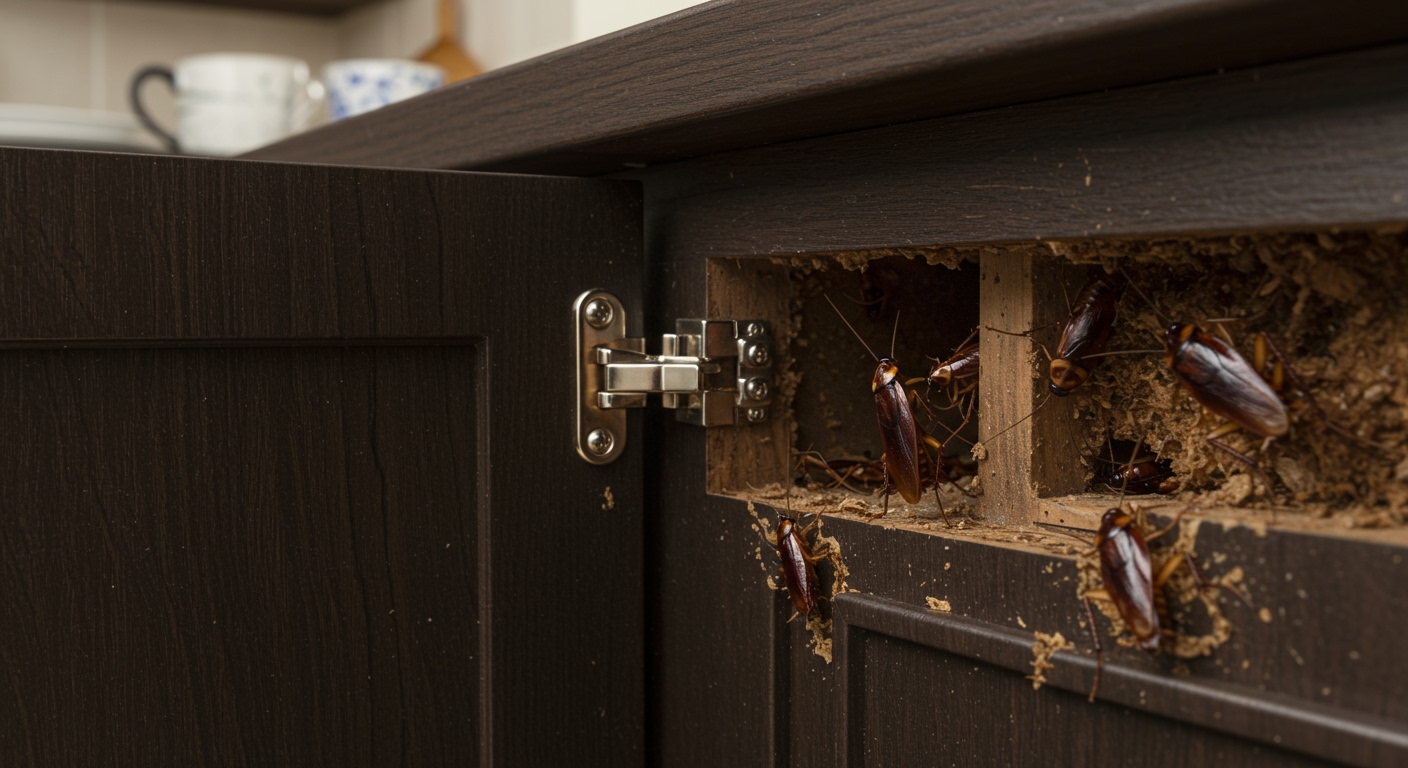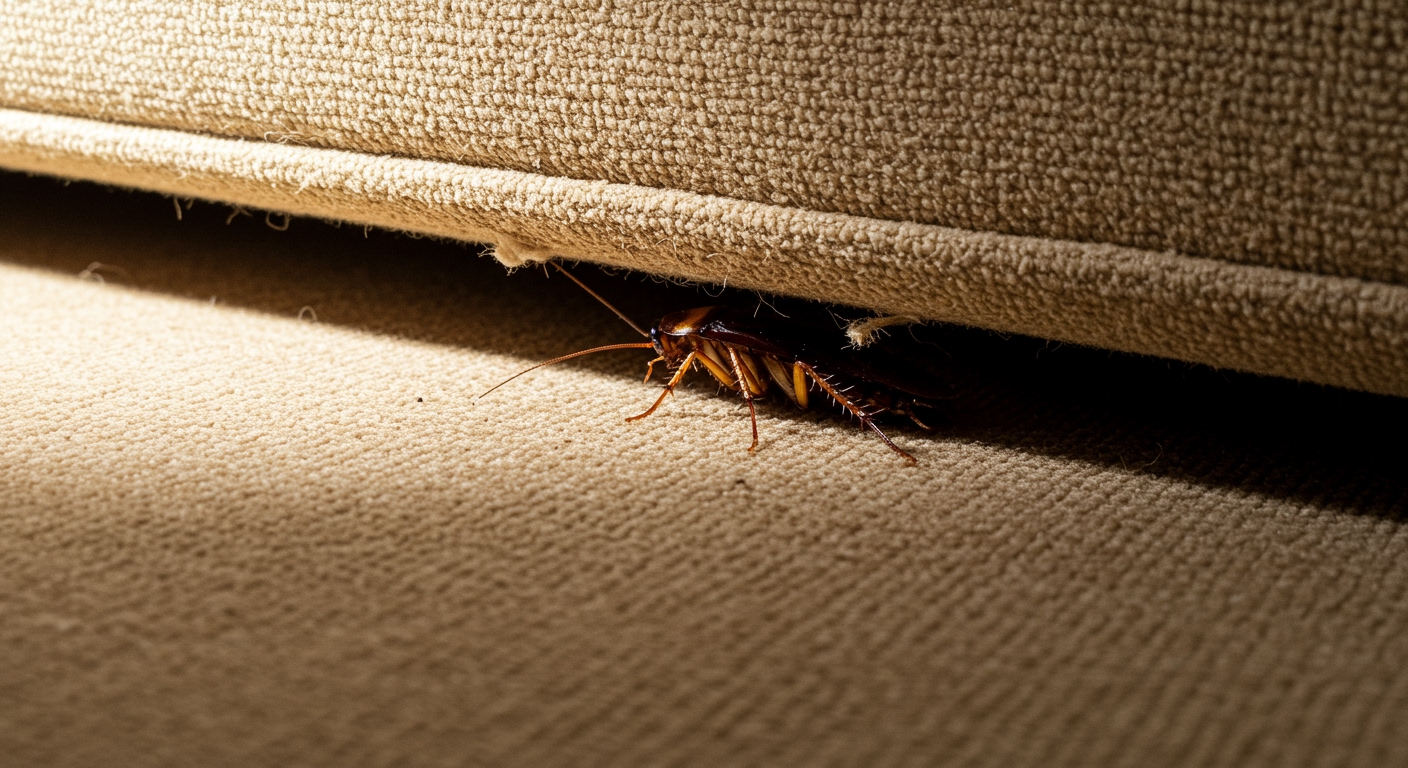The unsettling reality of finding unwanted guests in your home can be distressing, especially when those guests are cockroaches. These resilient pests are masters of concealment, and often, one of their prime targets for shelter and breeding is right under our noses: our furniture. If you’re asking where do cockroaches hide in furniture, you’re not alone, and this guide is designed to empower you with the knowledge to unmask, locate, and combat these sneaky invaders effectively.
Understanding the Allure: Why Furniture Becomes a Cockroach Harbor
Furniture isn’t just a place for us to relax; for cockroaches, it’s a five-star hotel offering everything they need for survival and reproduction. Understanding their basic needs helps us predict their preferred hiding spots.
- Darkness and Seclusion: Cockroaches are nocturnal creatures, meaning they thrive in hidden, undisturbed areas during daylight hours. Furniture offers countless such retreats.
- Warmth: Enclosed spaces, especially those near electronics (think entertainment units), provide ideal, consistent temperatures that roaches crave.
- Moisture: Accidental spills, humidity, or proximity to damp areas can make furniture attractive to these moisture-loving pests.
- Food Sources: Crumbs, spilled drinks, pet food residue, even shed skin cells, fabric fibers, and paper can sustain a cockroach colony if primary food sources are scarce [1].
- Safety and Breeding Grounds: Furniture provides protection from predators (like us!) and offers ideal, undisturbed crevices for egg-laying (oothecae).
Deep Dive: Specific Cockroach Hiding Spots in Furniture
Cockroaches are incredibly adaptable, capable of flattening their bodies to squeeze into unbelievably tight spaces. Knowing their preferred nooks and crannies is the first step in a successful inspection
A. Upholstered Furniture (Sofas, Couches, Recliners, Chairs)
Upholstered pieces are particularly appealing due to their numerous layers and soft materials.
- Under and Within Cushions: Loose cushions, deep crevices, and seams are common hideouts. Food particles, a major attractant, often accumulate here.
- Beneath the Frame: The underside of couches and chairs, especially the dust cover fabric (the thin material stapled to the bottom), provides a dark, undisturbed area.
- Hollow Legs and Internal Structures: Voids within furniture frames offer excellent concealment, allowing roaches to move unseen.
- Around Zippers and Fasteners: Small gaps near zippers or other fasteners provide easy entry points into the furniture’s interior.
B. Wooden Furniture (Dressers, Cabinets, Tables, Wardrobes, Antique Pieces)
Even solid wooden furniture can harbor roaches, thanks to natural wear and construction.
- Cracks and Crevices: Any unsealed gaps in joints, seams, or natural wood can serve as a refuge.
- Drawers and Cabinets: Inside drawers, along drawer slides, behind and beneath liners, and in cabinet corners are frequent infestation sites. Spilled food or crumbs in kitchen cabinets are a strong attractant.
- Behind Backings and Kickboards: The often-unseen rear panels of dressers, entertainment centers, and cabinets are prime, undisturbed spots.
- Antique Furniture: Older pieces may have more natural wear, numerous cracks, and undisturbed areas due to less frequent movement, making them particularly vulnerable to infestation.
C. Bedroom Furniture (Bed Frames, Nightstands)
Your sanctuary can quickly become a roach haven if you’re not vigilant.
- Bed Frames: Cracks in wooden or metal frames, especially around joints and headboards, can house roaches.
- Box Springs: The fabric covering and internal structure of box springs offer ample hiding spots.
- Nightstands and Dressers: Similar to other wooden furniture, drawers and backings are key areas to inspect.
D. Electronics Within Furniture & Other Concealed Spots
The warmth generated by electronics is a powerful draw.
- Inside Entertainment Units: Warmth from TVs, game consoles, internet routers, and other electronics attracts roaches. They can enter through vents and small openings [2].
- Wall Decor & Behind Pictures: Framed items hanging on walls can create secluded, dark spaces perfect for roaches to harbor.
- Clutter and Storage: Piles of papers, books, packaging, and cardboard boxes near or within furniture provide temporary cover and breeding sites.
Identifying the Enemy: Signs of a Cockroach Infestation in Furniture
Early detection is crucial for effective elimination. Look for these tell-tale signs to figure out where do cockroaches hide in furniture in your home.
A. Visual Sightings
- Live Cockroaches: Spotting roaches scurrying when furniture is moved or lights are turned on. Daytime sightings often indicate a larger, more severe infestation due to overcrowding.
- Dead Cockroaches: Finding deceased roaches can also be an indicator of an active or recent infestation.
B. Physical Evidence
- Cockroach Droppings: Small, black, pepper-like specks or coffee ground-like particles; larger roaches produce cylindrical droppings. Often found in drawers, under cushions, or along furniture joints.
- Egg Casings (Oothecae): Oval-shaped, brown (American/German cockroach) or reddish-brown (Oriental cockroach) capsules found in cracks, seams, or behind furniture. Each can contain numerous nymphs.
- Shed Skins (Exoskeletons): Translucent, hollow skins left behind as nymphs grow and molt.
- Smear Marks: Dark, greasy streaks on surfaces, particularly in damp areas or where roaches frequently travel.

C. Sensory Clues
- Musty or Oily Odor: A distinct, unpleasant smell, often described as musty, can permeate infested areas, especially with larger populations.
D. Damage to Furniture
- Chew Marks: While often on food packaging, cockroaches can also damage items like leather, books, and fabrics [3].
The Hunt: How to Thoroughly Inspect Your Furniture for Roaches
A methodical approach is essential when you’re trying to pinpoint where do cockroaches hide in furniture.
A. Preparation
- Gather Tools: Flashlight, gloves, magnifying glass (optional), screwdrivers (for dismantling), sticky traps.
- Clear the Area: Move furniture away from walls and remove any clutter around it.
B. Inspection Techniques
- Visual Scan: Systematically examine all visible surfaces, paying close attention to seams, crevices, and joints.
- Flashlight Power: Use a bright flashlight to illuminate dark areas, cracks, and under sections of furniture.
- Dismantle When Possible: Carefully remove cushions, empty drawers, and if feasible, check behind detachable backings. Inspect each item removed before setting it aside.
- Tap and Watch: Gently tap on wooden frames or hollow areas and watch for scurrying roaches.
- Check for Moisture: Inspect any dampness in or around the furniture, as roaches are drawn to humid environments.
- Consider Sticky Traps: Place sticky traps in suspected areas to monitor activity and confirm presence.
Action Plan: What to Do If You Discover Cockroaches in Your Furniture
Once an infestation is confirmed, swift action is key to successful elimination.
A. Immediate DIY Measures (for minor to moderate infestations)
- Thorough Vacuuming: Use a powerful vacuum with a crevice tool. Focus on seams, joints, cracks, and under cushions. Immediately empty the vacuum canister or dispose of the bag outdoors in a sealed trash bag to prevent re-entry. A HEPA filter is recommended to control dust.
- Steam Cleaning: Use a steam cleaner (ensuring it reaches at least 160°F or 70°C) on upholstered furniture, focusing on cracks and crevices to kill roaches and eggs. Ensure furniture dries completely to prevent mold.
- Disinfect Surfaces: Wipe down hard surfaces with a disinfectant spray or a 1:1 vinegar-water mix.
- Targeted Insecticides (Use with Caution):
- Diatomaceous Earth (DE): Sprinkle food-grade DE in cracks, joints, and other hiding spots. It dehydrates roaches on contact. Apply in dry areas; wear gloves and a mask.
- Boric Acid: Apply a fine layer behind furniture and along walls. It acts as a stomach poison and desiccant. Mix with an attractant like peanut butter for bait stations. Keep out of reach of children and pets.
- Roach Baits (Gel or Bait Stations): Place commercial gel baits or bait stations in strategic locations near furniture legs, behind drawers, and in cabinet corners. Roaches ingest the poison and spread it to the colony.
- Natural Repellents (as a deterrent, not a killer): Bay leaves, essential oils (peppermint, eucalyptus), garlic/onion paste, lemon peels, clove/cinnamon sachets can deter roaches due to strong scents, but should not be relied upon for eradication.
B. When to Call Professional Pest Control
- Severe Infestations: If you see many roaches, particularly during the day, or if DIY methods are ineffective.
- Persistent Problem: If the infestation returns despite your best efforts.
- Health Concerns: Cockroaches carry diseases and allergens, posing health risks [4].
- Expert Solutions: Professionals have access to stronger, targeted treatments (e.g., IGRs, professional-grade sprays, dusts, fogging) and can ensure complete eradication.

Proactive Measures: Preventing Future Cockroach Infestations in Your Furniture
Prevention is always better than cure, especially when it comes to knowing where do cockroaches hide in furniture.
A. Maintaining Impeccable Hygiene
- Regular Cleaning: Routinely clean all furniture surfaces, vacuuming thoroughly, especially under cushions and behind items.
- Food Management: Avoid eating on or near furniture, or clean up spills and crumbs immediately. Store all food in airtight containers.
- Waste Disposal: Keep garbage in tightly sealed containers and empty them regularly.
B. Eliminating Harborages
- Seal Cracks and Crevices: Inspect and seal any gaps, holes, or cracks in wooden furniture with wood filler or caulk. Seal gaps in walls and around baseboards near furniture.
- Declutter: Minimize clutter around and on furniture, especially paper and cardboard, to remove potential hiding spots.
- Address Moisture: Fix any leaks immediately and use dehumidifiers to reduce humidity, especially in damp areas like basements. Keep fabric-based furniture dry.
C. Regular Inspections
- Conduct routine checks for signs of cockroaches, even if you don’t suspect an infestation.
Special Considerations: Moving and Pest Transfer
Moving can inadvertently transfer pests to a new home, turning your new beginning into a nightmare.
A. Pre-Move Inspection & Cleaning
- Thorough Examination: Inspect all furniture, appliances, and electronics for signs of roaches (eggs, droppings, live insects) before packing.
- Deep Clean Everything: Wipe down surfaces, vacuum crevices, and clean appliances thoroughly.
- Launder All Fabrics: Wash clothes, linens, and curtains in hot water and dry on high heat, then pack in sealed plastic bags.
B. Smart Packing
- New, Sturdy Boxes: Use new, high-quality moving boxes. Avoid used cardboard, as it can harbor pests and its adhesive can attract them [5].
- Plastic Bins: Opt for sealed plastic bins with lids over cardboard boxes.
- Seal Everything: Individually seal smaller items and electronics in plastic bags.
C. Post-Move Vigilance
- Unpack with Care: Unpack in a clean, open area, preferably outside. Inspect each item again before bringing it inside your new home.
- Dispose of Packing Materials: Immediately discard all packing boxes and materials to prevent them from becoming new hiding spots.
- Consider Professional Treatment: If you suspect an infestation from your old home, consider professional treatment for your new residence before or shortly after moving in.
D. Purchasing Used Furniture
- Hard Surfaces Preferred: Opt for furniture with hard surfaces (tables, chairs) over upholstered pieces (couches, mattresses), which offer more hiding spots and are harder to clean.
- Rigorous Inspection: Always conduct a thorough inspection of used furniture for any signs of insect activity before bringing it into your home.
- Isolate and Clean: If purchased, isolate the furniture in a garage or porch for several days and clean it thoroughly before integrating it into your living space.

Conclusion: Reclaiming Your Home from Cockroaches
Understanding where do cockroaches hide in furniture is the first powerful step towards reclaiming your living space. Successful cockroach control involves a multi-faceted approach, combining vigilant inspection, thorough cleaning, targeted treatments, and proactive preventative measures. While DIY methods can be effective for minor issues, remember that professional pest control is a valuable resource for persistent or severe infestations. By consistently applying these strategies, a comfortable, pest-free living space is achievable.
References
- [1] Orkin. Cockroach Diet & What Roaches Eat.
- [2] Smith’s Pest Management. Are Cockroaches Attracted to Electronics?
- [3] Do My Own Pest Control. Cockroach Damage – What Do Roaches Eat?
- [4] U.S. Environmental Protection Agency. Health Effects of Cockroaches.
- [5] Terminix. Cockroaches in Used Cardboard Boxes.



